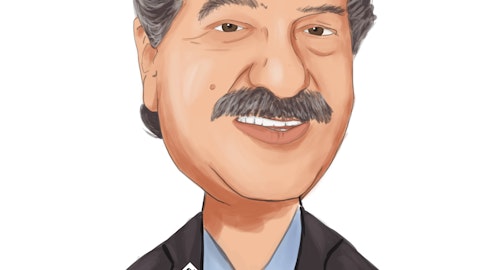Mark Casale : No, I think it’s been pretty consistent. Really over the last 6 to 12 months in terms of just where it is in terms of where we see it in terms of our earned premium yield. Like we had mentioned a while ago, here that we wanted to see new pricing for us get closer to where the base premium yield. And we’re there now. And so I think the unit economics of the business are good. In terms of pricing, though, again, I’d like to take a step back and just try to give investors a little bit more context because I’m not sure — the change in pricing has really is appreciated by the investor community. So we always talk about 3 changes to the business model since the GFC, right? You have reinsurance, which has out the mezz risk, which we think is important.
There’s the regulatory changes that are substantial, right, qualified mortgage, the strength of the GSE systems, forbearance, all those things have helped the business. I think the pricing engines have been a significant change to the industry. And the reason is it’s given all of the MIs a lot more flexibility and how they can bring price to the consumer. And I think because of that, I think in the past, investors have said, well, there’s not a lot of discipline in the industry. And I think that, again, it’s not appreciated just how the pricing was really brought to the consumer 5 years ago, in order for a price change to be made in the industry, you had to refile in all 50 rates, you had to change your card, one card, you had to usually take it to 2 or 3 of the top banks in the country.
And really, they decided where — because they didn’t have this — there was a system, the inability of their systems to program in like 6 different cards, so they could only program in one card. What’s going to happen here? They’re going to program in the lowest card. So they’re going to get 6 cards. And whoever had the lowest, everyone was forced to that. So you didn’t have a lot of flexibility. So people confuse that with a lack of discipline per se, but it’s really just kind of — it’s a little bit of game theory, right, in terms of when you put 6 guys up against 1 lender. The lender had the pricing power in the industry. And I think with the engines, that’s changed significantly. Now we all file a range of rates, we can change rates much more frequently.
It’s really become what we said it was going to be, which is a risk management tool. It allows all the MIs to pick their spots, right? People have different geographical preferences, different parts of the capital structure, FICO. I think that’s great. The lenders win, and the borrowers win. But just, again, give you more evidence over the last 12 months from here, we must have raised pricing 12x different times, like in different places, maybe a tail here, an MSA there. Once in a while across the board, if that was under the old card system, we would have had 1 shot at raising pricing. And whatever shot we had would have been mitigated by the competitive factors. And again, I think it’s underappreciated. I think there’s a form of pricing power with the mortgage insurers now.
And again, if you just look at our — and it’s still good economics to the borrower. The borrower wins, the lenders win, and I think MIs now have the chance to kind of shape their portfolios and pick the spots where they want to be in much similar to how other insurance companies operate.
Mihir Bhatia : Got it. I really appreciate that answer. So to take a step back. On the — maybe switching gears a little bit to the title side. And look, I understand you’re building that business. It’s a long-term play for you. It’s not about a quarter or something like that. But as you position that business for long-term success. Is the idea here in the near term, the focus, hey, we need to build out the infrastructure for the next few quarters, a little bit of an investment period before we start really driving revenue growth. Maybe just talk about what you expect. How you’re looking at that business for the next 2, 4 quarters even as you look at the long term?





